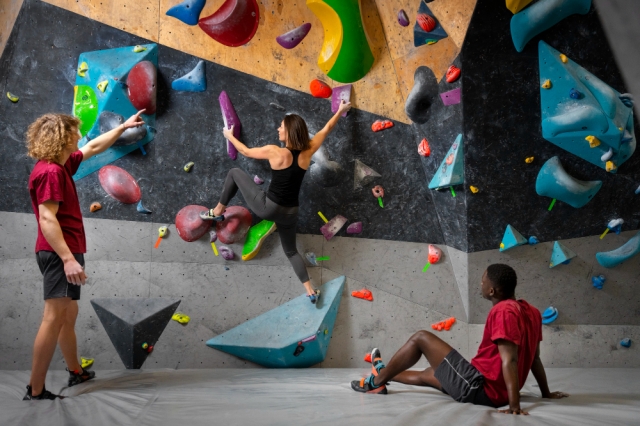Corporate team-building refers to strengthening relationships and improving collaboration among employees in the workplace. By fostering communication, trust, and cooperation, team-building activities play a crucial role in boosting workplace dynamics and overall productivity.
While traditional exercises like workshops and group discussions have their place, some companies are turning to more exciting options. For instance, corporate team-building in Abu Dhabi can be done in an indoor climbing and skydiving park like CLYMB Yas Island, Abu Dhabi. This offers not only a break from the daily grind but is also an effective way to build trust and camaraderie in a fun, dynamic and high-energy setting.
Team-building offers a wide range of benefits. Indoor climbing and skydiving team-building activities, in particular, amp up the pressure. This makes them not only fun but also highly effective at bringing out hidden talents and leadership skills and enforcing synergy, cooperation, and collaboration among colleagues.
Indeed, active team-building activities like indoor skydiving and indoor climbing games are not just fun. They also positively impact your team in the following ways:
1. Improved Communication
Team-building activities encourage open dialogue and help team members communicate more effectively. By working together on various challenges, employees can express their ideas clearly, listen to others, and provide constructive feedback. These exercises build important skills like active listening, nonverbal communication, and the ability to collaborate in group settings.
Whether during problem-solving activities or trust-based tasks, employees learn to exchange information and ideas more confidently, leading to better workplace communication. For instance, in an indoor wall climbing relay, a team member climbs while another serves as the spotter or guide. The climber relies on explicit instructions from the ground — whether to change direction, adjust their grip, or take the next step up — while the spotter provides timely, precise guidance and encouragement.
2. Enhanced Trust and Collaboration
Team-building activities force team members to rely on each other in new, often challenging situations.
For instance, in an indoor climbing exercise, the climber depends on their colleague to manage the safety of their rope and provide guidance. This collaboration fosters mutual trust and encourages teamwork as both individuals work toward the same goal: completing the climb.
Team-building activities, thus, help break down trust issues and increase everyone’s reliance on others. As participants work through tasks together, they learn to trust that their teammates will support them and collaborate effectively, which enhances overall teamwork and reduces workplace friction. The shared experiences also help build confidence in other people’s abilities.
3. Increased Morale and Motivation
Team-building activities can significantly boost employee morale by providing fun and engaging experiences that break the routine of daily work. For instance, an indoor skydiving formation challenge, which involves teams attempting to create specific formations while in the air as instructed by a skydiving instructor or taskmaster, is a thrilling, fast-paced activity that encourages team members to cheer each other on, laugh together, and enjoy the excitement of working as a unit.
Experiences like these allow employees to connect in a relaxed, enjoyable setting and feel valued by their colleagues, the leadership and the company. High morale leads to increased motivation, positively impacting productivity and job satisfaction.
When employees feel energized and appreciated, they’re more committed to their work and contribute positively to the workplace culture.
4. Problem-Solving and Creativity
Team-building activities challenge participants to think creatively and solve problems together. These exercises often simulate real-world challenges, pushing teams to find solutions under pressure, much like in the workplace. By forcing them to leave their usual work environment, these tasks force employees to face new scenarios requiring quick thinking and innovative approaches.
For example, an indoor climbing route puzzle game can force team members to work together to plan and complete a complex climbing route. The twist? Each climber can only take a specific path, and the team must strategize on the best order of participants and their team approach to reach the top.
This activity encourages problem-solving and creative thinking as participants discuss their options and work together to determine how best to navigate the wall so their team will succeed and win. This challenge helps improve critical thinking and adaptability, translating into stronger problem-solving skills at work.
5. Leadership Development
Team-building activities offer valuable opportunities to identify and nurture leadership qualities within the team. They give individuals the chance to step into leadership roles, guiding others, making decisions, and motivating the group toward a shared goal. By providing a low-stakes but high-pressure environment to test and grow these skills, team members can develop their confidence and ability to lead.
In a team flight coordination activity, for instance, the team member designated as flight formation coordinator is thrust into a leadership role. They must communicate with the instructor to receive instructions and effectively lead their teammates to ensure everyone moves in sync during their team’s flight.
This experience allows this team member to practice their decision-making and communication skills, particularly in a fun but high-pressure setting. The skills they learn and unlock in this activity directly apply to the workplace.
The Lasting Impact of High-Energy Team-Building Activities
Consider holding your next team-building at an indoor facility where you can climb and skydive in Abu Dhabi. High-energy team-building activities that challenge teams to do rigorous tasks like indoor wall climbing and skydiving offer numerous benefits for teams.
Such team-building activities improve communication, foster trust and collaboration, boost morale and motivation, enhance problem-solving and creativity, and provide opportunities for leadership development. These dynamic experiences strengthen workplace relationships and build essential skills that improve productivity and job satisfaction.






